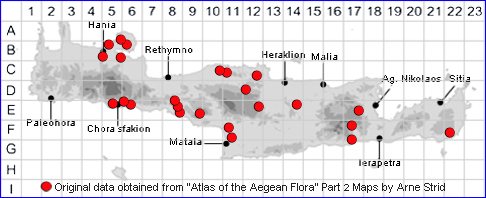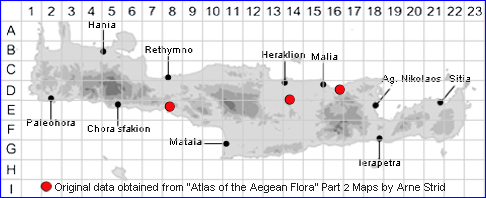

SPECIES DESCRIPTION
GARIDELLA NIGELLASTRUM
Including Garidella unguicularis
Family:- RANUNCULACEAE
Common Names:- None
Synonyms:- Nigella nigellastrum
Meaning:- Garidella Meaning unknown
Nigellastrum (L) Medieval Latin name for corn-cockle.
General description:- Herbaceous plant.
Stems:-
1) 30-50 cm, slender, simple or with ascending branches.
Leaves:-
1) Alternate, deeply divided, with narrow parallel-sided segments, glabrous.
2) Cauline, deeply divided into linear segments.
Flower:-
1) Solitary on long pedicels.
2) Perianth-segments, 3-4 mm, greenish, tinged purplish or reddish.
3) Honey-leaves, 7-9 mm, the claw not exserted.
4) Lower lip of the limb oblong, narrowed at base, divided into two linear-oblong
lobes.
5) Anthers dark brown.
Fruit:-
1) Seeds rugose with anastomosing ridges.
Key features:-
1) Honey-leaves 7-9 mm, oblong.
2) Anthers dark brown.
Habitat:- Dry open shrubby vegetation, fallow fields, olive groves, gorges, roadsides
and other disturbed habitats. 0-500 m.
Distribution:- Limited distribution in the Aegean area, but widely scattered in the
Mediterranean area, eastwards to Caucasia and N Iran. Somewhat sparsely
scattered across Crete, mainly in the central areas.
Flowering time:- Apr-May.
Photos by:- Zacharias Angourakis
FAMILY AND GENUS DESCRIPTIONS
RANUNCULACEAE
General description:- Herbs or rarely woody climbers.
Leaves:- Alternate, without stipules (exstipulate), rarely opposite or stipulate.
Flowers:- Usually hermaphrodite and radially symmetrical (actinomorphic), the
sepals, petals and stamens inserted on the receptacle below and free from the
ovary (hypogynous). Perianth petaloid or sepaloid, arranged in whorled (verticillate).
Honey-leaves (petaloid structures bearing nectaries) often present, sometimes
funnel-shaped (infundibuliform). Stamens numerous, usually spirally arranged, with
the anthers facing and opening outwards, away from the centre of the flower
(extrorse). Carpels 1 to many, usually free and spirally arranged.
Fruit:- Usually of 1 or more follicles or a head of achenes.
GARIDELLA
Leaves:- Usually 2- or 3-pinnatisect with linear segments.
Flowers:- Perianth-segments 5, petaloid, falling early (caducous). shorter than the
honey-leaves. Honey-leaves 5, opposite to and much smaller than the perianth-
segments. Styles c. 1 mm.
Fruit:- Follicles 2 or 3, united below, inflated; styles c. 1 mm.
Key features:-
1) Honey-leaves longer than the caducous perianth-segments.
GARIDELLA UNGUICULARIS
Synonyms:- Nigella unguicularis
Meaning:- Unguicularis (L) With a small claw.
Resembling Garidella nigellastrum in vegetative characters as follows:
1) Sepals slightly shorter and broader.
2) Petals with a long, slender claw.
a) lower lip of the limb c. half as long as the claw.
b) broadly ovate, cordate at the base, shortly bifid, incurved at almost
right angles to form a roof over the follicles.
3) Anthers yellow.
Habitat:- Dry open shrubby vegetation, scrubland vegetation and roadsides 0-500
m.
Distribution:- A rare species known from only a few locations on Crete. The only
ones in Europe. A species of E Turkey, W Syria, Palestine and Iraq, First reportÚd
from Crete by Arne Strid (1969). With a subsquent discovery in 2023 by Manolis
Petakakis in the Neo Chorio region of west Crete.
Flowering time:- May-early June
Photos by:- Manolis Petakakis
~~~~~~~~~~~~~~~~~~~~~~~~~~~~~~~~~~~~~~~~~~~~~~~~~~~~~~~~

